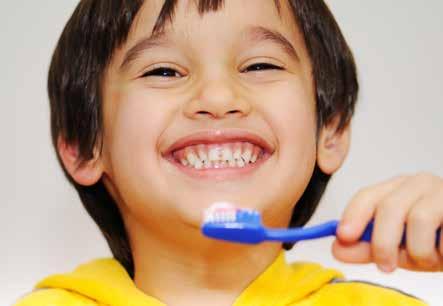Looking after your child’s dental health
With the increase of sugary foods, tooth decay is on the rise amongst kids in this region. So what can you do to look after your child’s dental health?
Although figures are not available for the UAE or Middle East, UK healthcare professionals have reported an “oral health crisis” in children. This crisis has seen over 40,000 children put under general anaesthetic in hospital to have teeth extracted in recent years. According to health experts, the 17% increase in tooth extractions in hospitals is attributable to tooth decay caused by sugar in children’s diet.

Tooth decay is the breakdown, or destruction, of tooth enamel. Enamel is the hard, outer surface of a tooth. Tooth decay can lead to cavities (also called caries), which are holes in the teeth that bacteria can penetrate. So, what causes tooth decay in a child? Tooth decay is caused by bacteria, amongst other things. It can happen when foods containing sugars, starches and other carbohydrates are left on the teeth. These foods include milk, soda, raisins, sweets, cake, fruit juices, cereals and bread.
Bacteria that normally live in the mouth react with these foods, resulting in the production of acids. The combination of bacteria, food, acid and saliva forms a substance called ‘plaque’ that sticks to the teeth. Over time, the acids made by the bacteria eat away at the tooth enamel, causing cavities.
Children at risk of tooth decay
All children have bacteria in their mouth, so they are all at risk of tooth decay. But the following may increase your child’s risk:
- High levels of the bacteria that cause cavities.
- A diet high in sugars and starches.
- Water supply that has limited or no fluoride in it.
- Poor oral hygiene.
- Less saliva flow than normal.
Symptoms of tooth decay
The following is the common way that teeth develop decay and cavities. But decay may be a bit different for each child:
- White spots begin to form on the teeth in areas affected. These spots mean that the enamel is starting to break down. They may lead to early sensitivity in the teeth.
- An early cavity appears on the tooth. It has a light brown colour.
- The cavity becomes deeper. It turns a darker shade of brown to black.
The symptoms of tooth decay and cavities vary from child to child. Cavities don’t always cause symptoms. Sometimes children don’t know they have one until their dentist finds it. But your child may feel pain in the area around the tooth and sensitivity to certain foods, such as sweets and hot or cold drinks.
Diagnosing tooth decay in children
Your child’s dentist can usually diagnose tooth decay based on a complete history of your child, an exam of your child’s mouth and dental x-rays.
Treatment at the dentist
Treatment will depend on your child’s symptoms, age, and general health. It will also depend on how severe the condition is. In most cases, treatment requires removing the decayed part of the tooth and replacing it with a filling. Fillings are materials placed in teeth to repair damage caused by tooth decay. They are also called restorations. There are different types of fillings:
- Direct restorations: These need a single visit to place a filling directly into a prepared hole. These fillings may be made from silver, fine glass powders, acrylic acids, or resin. They are often tooth-coloured.
- Indirect restorations: These require two or more visits and are constructed with gold, base metal alloys, ceramics, or composites. Many of these materials can look like natural tooth enamel
Prevention of tooth decay in your child
You can help prevent tooth decay in your child with these simple steps:
- Start brushing your child’s teeth as soon as the first tooth appears in your baby’s mouth. Brush the teeth, tongue and gums twice a day with a fluoride toothpaste.
- Floss your child’s teeth daily after age two.
- For children younger than three years old, use only a small amount of toothpaste, about the size of a cooked grain of rice.
- Starting at age three, your child can use a pea-sized amount of toothpaste.
- Supervise as your child brushes his or her teeth when they are a little older.
- Prevent the transfer of bacteria from your mouth to your child’s by not sharing eating utensils. Don’t clean your infant’s pacifier with your saliva.
- Make sure your child eats a well-balanced diet.
- Limit snacks that are sticky and high in sugars, such as chips, sweets, biscuits and cake.
- If your child uses a bottle at bedtime, only put water in it. Juice or formula contain sugars that can lead to tooth decay.
- Schedule routine dental cleaning and exams for your child every six months.
- Talk with your local health clinic or dentist about using a fluoride supplement if you live in an area without fluoridated water. Also ask about dental sealants and fluoride varnish. Both are applied directly to the teeth at the dentist.
There are a number of factors that mean that your children will enjoy a bright healthy smile all their lives! Advances in dentistry combined with diligent care and attention to schedule regular a dental check-up routine will help to spot problems early – and in many cases, treat them painlessly!












Comments